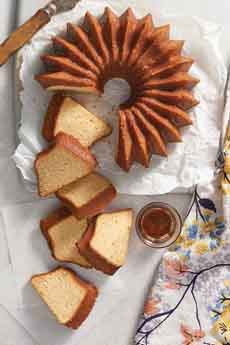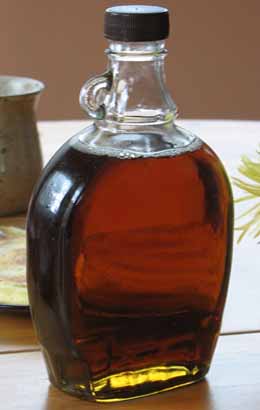RECIPE: Maple Pound Cake
 [1] Making this pound cake in a bundt pan provides eye appeal (photo courtesy King Arthur Flour).
|
While maple-flavored foods can be served year-round, they have fallen into the fourth-quarter slot, a time period that highlights everything made with maple and pumpkin. Going with the tradition, we decided to feature this maple pound cake for fall. If we had featured it in July, would you have been interested? This pound cake can be dressed up for dessert. We like creme anglaise as a dessert sauce (recipe), or a scoop of vanilla or maple walnut ice cream. Most often we enjoy it plain, as a snack or a brunch cake. Prep time is 25 minutes, bake time is 45 to 50 minutes. Ingredients For The Cake 1. PREHEAT the oven to 350°F. Lightly grease a 9- or 10-cup bundt-style pan. 2. COMBINE the flour, baking powder, baking soda and salt in a medium bowl. 3. BEAT together the butter and brown sugar in a separate bowl, until light and fluffy. Add the eggs one at a time, beating for a minute or two and scraping the sides and bottom of the bowl between additions. Mix in the maple syrup. 4. ADD half the flour mixture, followed by the sour cream, vanilla and maple flavor, and finally the remaining flour mixture. Mix until just combined, scraping the sides and bottom of the bowl between each addition. |
|
|
5. SCOOP the batter into the prepared pan and bake for 45 to 50 minutes, until a cake tester or toothpick inserted in the center comes out clean. Allow the cake to cool for 10 minutes in the pan, then turn it out onto a serving plate. While the cake is cooling… 6. MAKE the glaze. Combine the ingredients in a medium saucepan. Bring the glaze to a rapid boil, then reduce to a simmer and cook for about 5 to 8 minutes, until it thickens to a syrupy consistency. Remove the pan from the heat. 7. BRUSH the hot glaze over the warm cake. Allow the cake to cool completely before serving. 8. STORE unsliced at room temperature for several days; freeze for longer storage. Maple trees are indigenous to the U.S. In cold climates, the trees store starch in their trunks and roots before winter; the starch is then converted to a form of sugar, that rises in the sap in late winter and early spring. Early Native Americans, like the Algonquians of the Northeast, discovered the sweet sap inside maple trees, and processed it into syrup. At the beginning of the spring thaw, they made V-shaped incisions in tree trunks using stone tools, and inserted reeds or concave pieces of bark to run the sap into buckets. The first stage of concentrating the sap was by dropping hot cooking stones into the buckets to remove some of the water, or by leaving them outside overnight and removing the layer of ice that formed on top. Sugar bushes—stands in the forest—provided working spaces. Over time, processing improvements were developed. By the time European settlers arrived, the technique was to boil the sap over an open fire for a long time, until it concentrated into syrup. The Native Americans taught the Europeans how to make the syrup. The settlers improved the process by using augers to drill tapholes in the trunks, and by making wooden spouts to drain the sap into buckets. During the 17th and 18th centuries, Europeans used the maple syrup as a source of sugar, in both liquid and crystallized forms. It was local and free for the making, while cane sugar had to be imported from the West Indies. Today, maple syrup harvesters use plastic tubing (photo) to transfer the sap from the tree to the sugar shack, the building where it’s boiled into syrup. Here’s more on the production of maple syrup.
|
||



